By Bruce Bruemmer
This article was originally published in Hennepin History, Vol. 80, No. 2, 2021
Four “display” airplanes were parked around the cylindrical Cooper Theatre in St. Louis Park in preparation for a special premiere of the movie, Airport. Its first night on March 18, 1970, featured a benefit hosted by former vice president Hubert Humphrey and his wife, attracting a full house of 800 and raising $30,000 for residential programs and facilities for people with intellectual disabilities.¹ One star of the movie, Jacqueline Bisset, and the director, George Seaton, flew to Minneapolis to attend the event. The premiere was the culmination of a love fest between the Twin Cities and the production of arguably the first big-time Hollywood movie to shoot on location in Minnesota.
In 1957, Arthur Hailey, the grand-daddy of the airplane disaster motif, wrote a script for Zero Hour!, a film about airline pilots succumbing to food poisoning. He continued the genre in 1968 with his best-seller, Airport. Jet-age Airport became a franchise of three more airplane-related movies and induced Hollywood to produce a slew of disaster movies, usually commercial successes if not always tolerable films. The plot of Airport centers on the preparation and flight of Trans Global 2 to Rome. The manager of Lincoln Airport (Burt Lancaster) copes with another Trans Global plane stuck on the main runway, and is forced to direct flights over a noise-sensitive area. The pilot (Dean Martin) is distracted by his affair with a stewardess (Bisset), who has just informed him of her pregnancy. A self-described “little old lady” (Helen Hayes) sneaks on the plane as a stowaway. An unsuccessful and despondent salesman (Van Heflin) tries to buy a better life for his wife (Maureen Stapleton) by purchasing flight insurance and plotting to blow up the plane en route. George Kennedy, the only actor to appear in all the Airport movies, plays the ground airline engineer who fixes every-thing. And this is not even all of the stars!

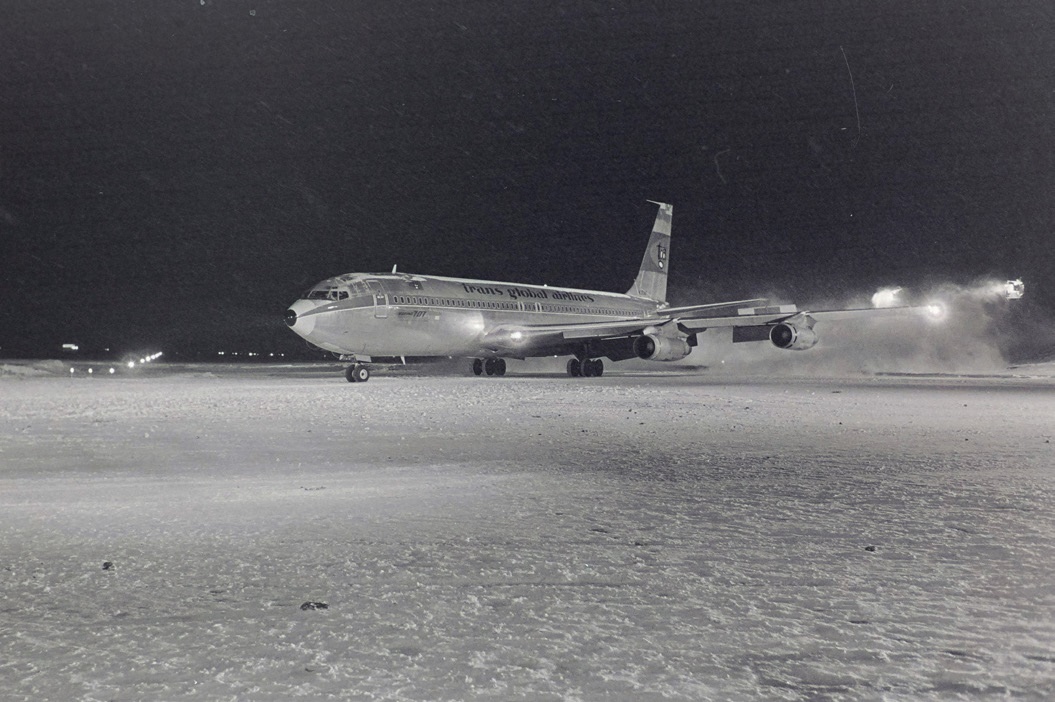
The Boeing 707, star of the movie Airport, moves along the taxiway at MSP in January 1969 with the Trans Global Airlines livery.
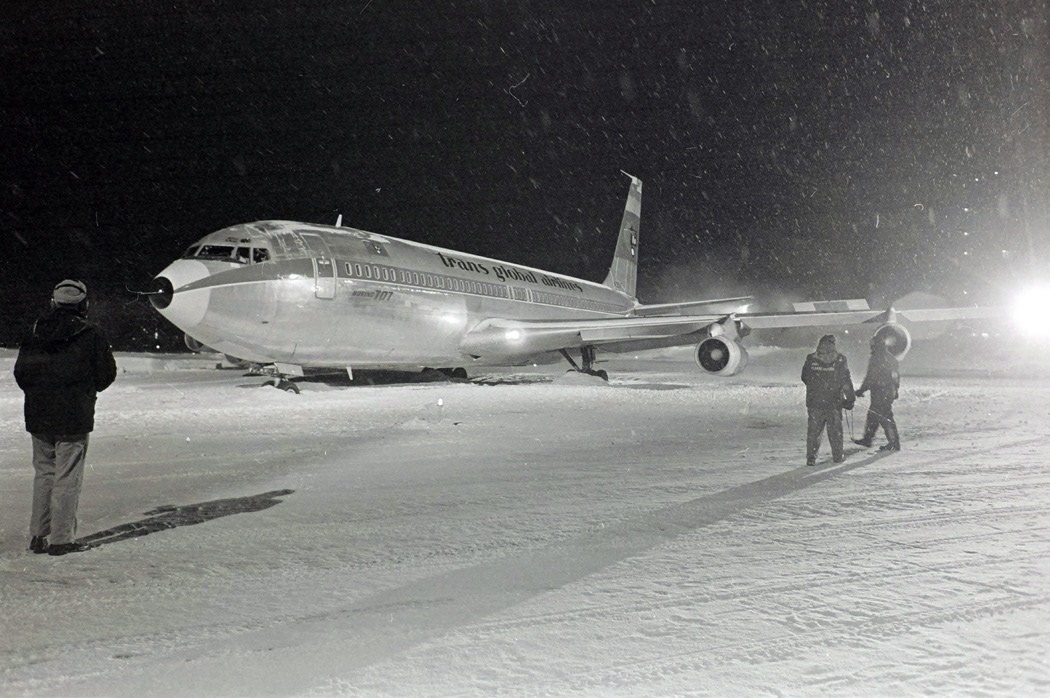
The Boeing 707, in Trans Global livery, takes its “stuck” position off the taxiway at MSP while the Airport film crew looks on.
Snow, stars, and long hours
Movie director Seaton wanted to shoot on location and needed a locale that could be made to look like a Chicago airport. He was attracted to Minneapolis-St. Paul International Airport (MSP) not by offers from a state film board, not by tax incentives, but the one thing locals love to loathe: snow. The premise of a blizzard and a plane stuck in the snow on a runway helped drive the tension in the movie, so the more snow, the better. Other sites were considered, but MSP was attractive not only for its winter conditions, but also its light airplane traffic at night, and its modern-looking airport terminal, which opened in 1962. The Metropolitan Airports Commission (MAC) approved the use of the airport by Universal City Studios, and the Minneapolis Tribune announced the production on December 17, 1968. Most of the cast had been chosen by that time, so the big Hollywood names were announced in the article. Crews planned to arrive in January and finish by March. Most tantalizing for the local readers was the line, “A large number of extras will be needed for some of the scenes.”² Local columnists pounced on the announcement. Two days later, Will Jones had interviewed producer Ross Hunter about his discovery of Sandra Dee and Rock Hudson, and his hopes for discovering local talent and using “hundreds” of extras. The news sent Minneapolis Star columnist Barbara Flanagan “rushing to the closet for my tap shoes.”³
Ray Gosnell, the production manager, said “it’s always easier when you’re the first location company in a given area. Everybody wants to be in the picture. They don’t know it’s just a lot of standing around and getting very tired.” Residents in this given area were amped for the chance to for the chance to be in a Hollywood movie, and the floodgates were opened toward the end of January 1969 when the Minnesota Employment Service announced it was taking applications for extras. The basic rate was $15 per night with $3 for a food break. In the application, women were required to describe themselves as collegiate, chic and statuesque, matronly, or mod. The movie got special dispensation from the state to include a question about race. The producers needed the crowd scenes to reflect the diversity of a typical metropolitan area, and in 1970, only 2.7 percent of the five-county metro area were people of color.⁴
Within five days, the producer ran an advertisement in the paper thanking Twin Citians for an overwhelming response that “resulted in more applications . . . than can be accepted,” a polite way of telling people to give up.⁵ About 7,500 people applied, and the largest single call was for 850 extras. Temporary employment was not the only contribution the film made to the local economy. The MAC got over $26,500 for equipment, materials and personnel at the airport. Energy Manufacturing provided 100 snowmobile suits to the predominately Californian production crew, and another firm received an order for 150 hand warmers. A local construction company dug a wooden apron on the field for the stuck Boeing 707 (nowhere near the real runway 29). W. R. Grace supplied 4,000 cubic feet of grey insulation to simulate the mud that was under the plane.⁶ The press had fun when it was discovered that the film had ordered 1,800 pounds of white plastic flakes from Wisconsin as a snow substitute. This was in addition to 8,000 pounds of corn flakes that were in snow scenes in case the real stuff proved problematic. In spite of all this spending, Airport did not generate close to the $3 to $4 million that producer Hunter claimed would come to Minnesota.⁷
Filming started in February and was scheduled for a month. The first star of the film was the Boeing 707 acquired from cargo carrier Flying Tigers. N324F would double as Trans Global’s plane that was stuck blocking the main runway, and also the airliner’s plane that was forced by the bomb to return to the airport. Except for the opening credits and the ending inspection of the disabled plane, all of the filming at MSP was conducted at night either in the terminal or outside on the field. The human stars arrived in the middle of February, starting with Heflin, an avid fisherman who came early to experience ice fishing. Unfortunately, the season had already ended, prompting Barbara Flanagan to suggest that an exception be made for him; “Think what a dandy image that gives us.” Never mind that he played the depressed bomber in the story. The other performers followed. Maureen Stapleton and Dean Martin came by train; neither liked flying — ironic since Martin played the pilot of the injured plane. Helen Hayes stayed at the Sheraton Ritz in Minneapolis, and the Tribune featured a photograph of the man-ager attaching a placard naming the suite after her.⁸
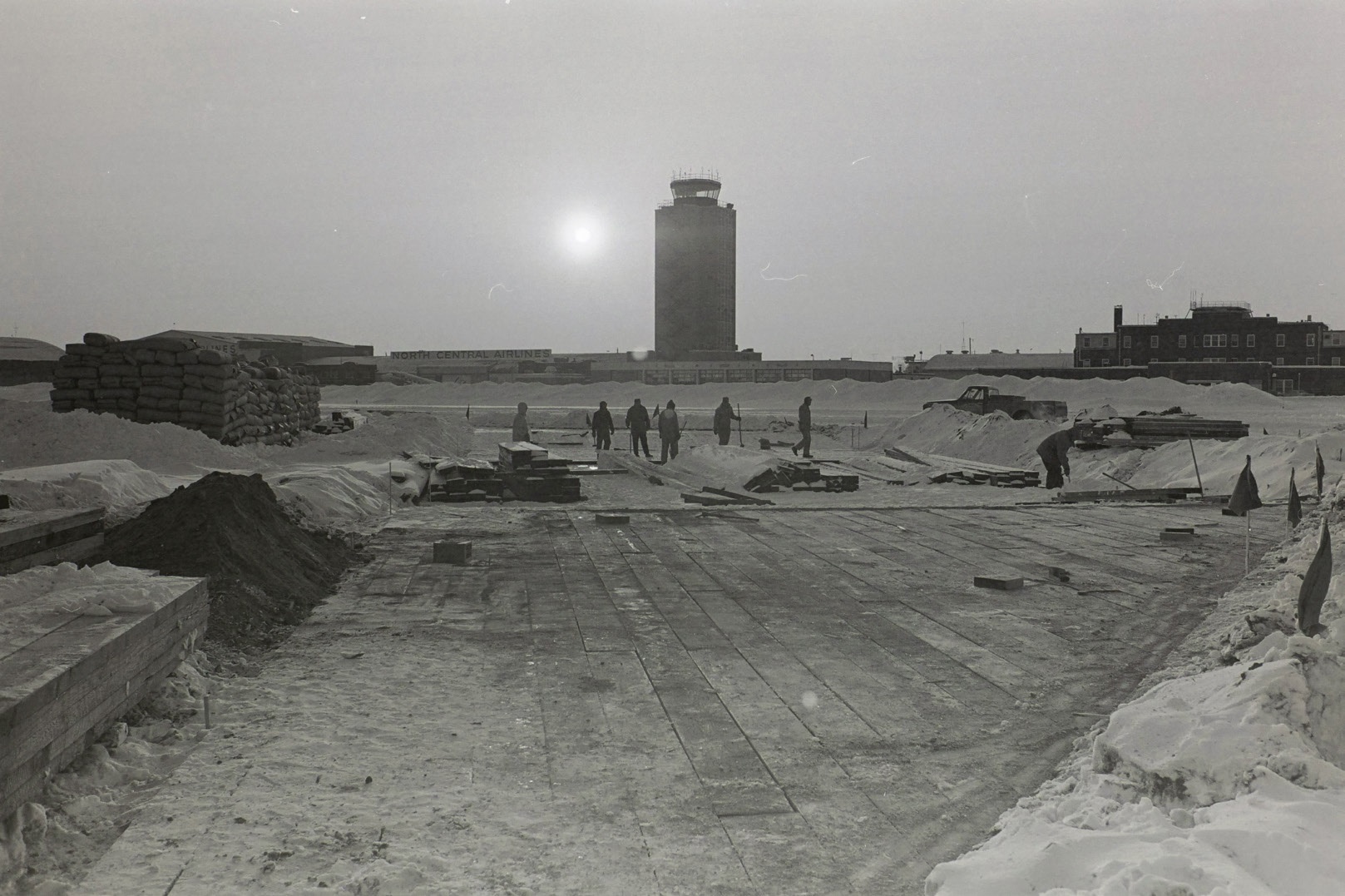
A crew prepares a floor of timbers off the MSP taxiway to support the Boeing 707 plane. In the background the North Central Airline hangar is left of the new control tower. To the right is the old airport terminal. Photos courtesy Minnesota Historical Society.
The biggest fuss was over Jean Seberg and Burt Lancaster. Tribune columnist Will Jones covered Seberg’s arrival on February 16 and dubbed her “Iowa’s Parisienne,” reflecting her birthplace and residence, respectively. Jim Klobuchar reported that Lancaster “left hundreds of housewives demoralized” at the airport by missing his plane. Barbara Flanagan was able to catch up to the actor jogging around the Milwaukee Road Station, where a photographer captured Yardmaster Dick Bourgerie joining in the exercise.⁹ Ross Hunter’s promise to discover some local talent eventually focused on Nancy Nelson. Nelson was in a show at the Old Log Theatre and was known to Twin Cities audiences through her modeling and as the “Princess of Prizes” of the local TV show, Bowlerama. The young actress initially missed the auditions because she had been fogged in at O’Hare Airport, but impressed the film’s casting director when they happened to cross paths at WCCO. She was cast in the speaking role of Bunnie, the salesperson who sells the bomber (Heflin) his flight insurance. She received much local press and went on to become a successful producer of early television infomercials.¹⁰
Truths of the day
Hailey’s book added a smorgasbord of social issues to the story, including abortion, mental stress and depression of our traffic controllers, and the practice of hawking travel insurance near ticketing counters to profit insurers and airports. In the movie these issues were diminished to avoid interfering with the plot. But the one issue that would resonate with Twin Cities audiences was flight noise. The fictional Lincoln Airport assumed the runway orientation of the real MSP; runway 29 was shut down while 22 took all the traffic, forcing flights over noise-sensitive Meadowbrook.¹¹ Most Minneapolis and Richfield residents could identify with Meadowbrook. At the same time the press was covering the production of Airport, readers could follow MAC’s consideration of a new airport in Ham Lake Township.
The movie gives a glimpse of the airport as it was seven years after its opening. Younger audiences will be dumbstruck at the surface parking and the color-coded concourses. The opening credits show snow-clearing equipment in action, including an odd device that directs flames at the surface of the runway. This was actually an innovation of MSP Airport Manager Roy Johnson, who combined it with sand to make ice-covered runways useable.¹² The control tower, built five years earlier, is shown, as is the old Super America filling station. The movie took pains to use Illinois plates on most of the autos that were parked or dropping people off, but glimpses of Minnesota plates remain.
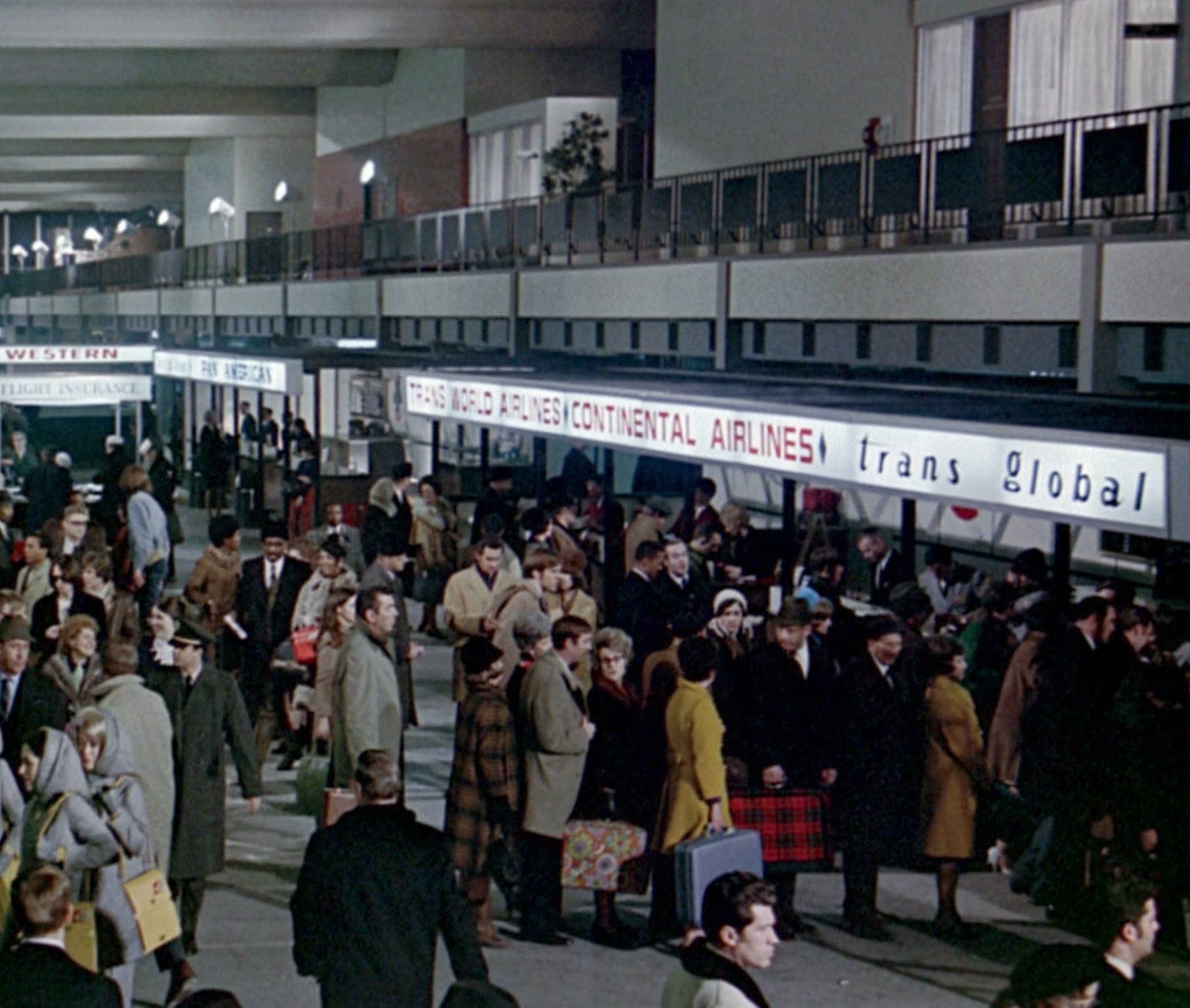
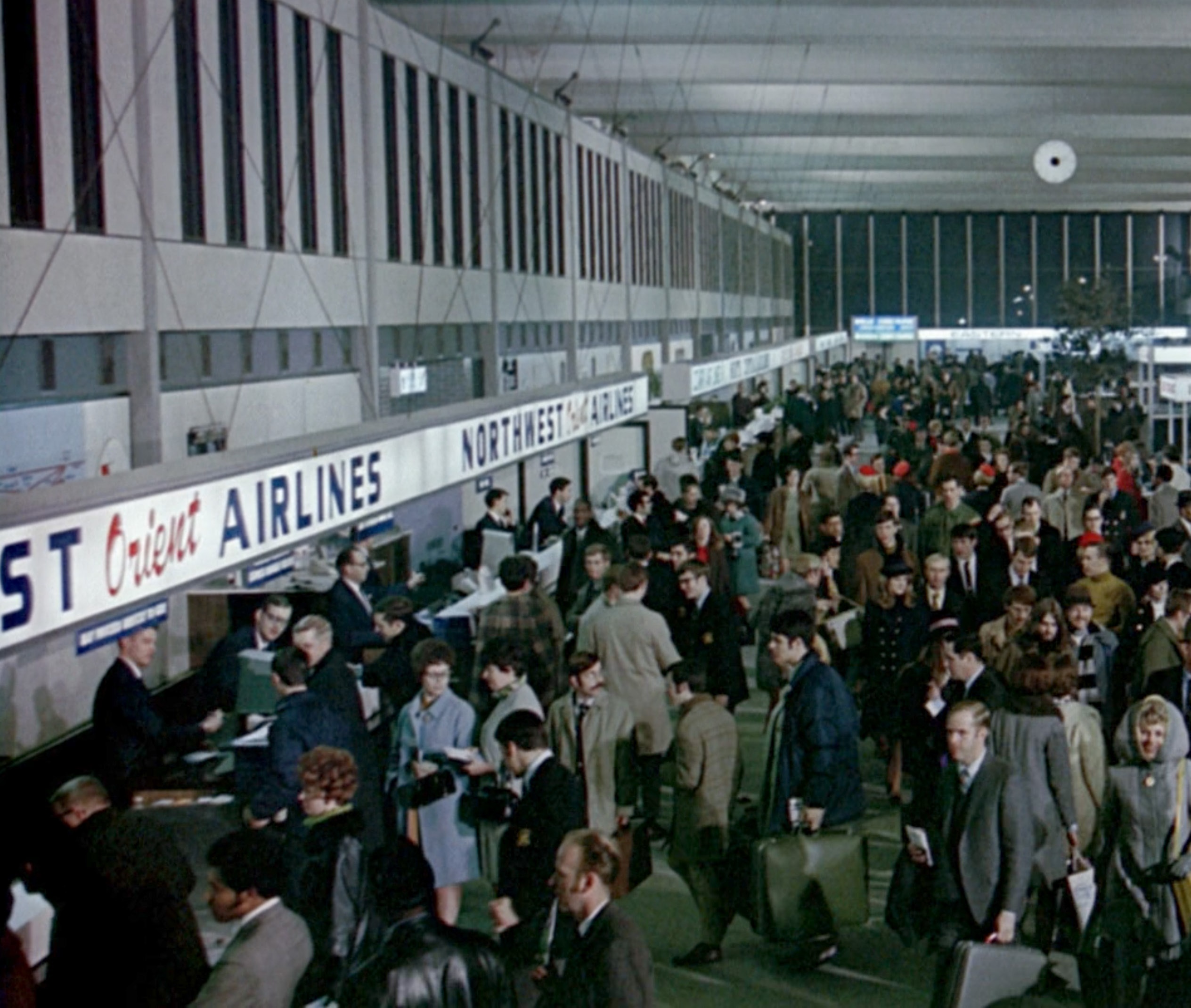
The opening shot of the MSP terminal in Airport. The left side was the real ticket counter. The right side with Trans Global was fictional. At center are Trans Global flight attendants in hooded suits sporting the “Airport Look” designed for the film by Edith Head.
Photo courtesy NBC Universal Media.

Local actress Nancy Nelson plays Bunnie, a flight insurance salesperson, opposite Van Heflin who has a bomb in his suitcase. The old telephone booths of the main terminal are in the background among the extras pacing the MSP terminal. Photo courtesy NBC Universal Media.
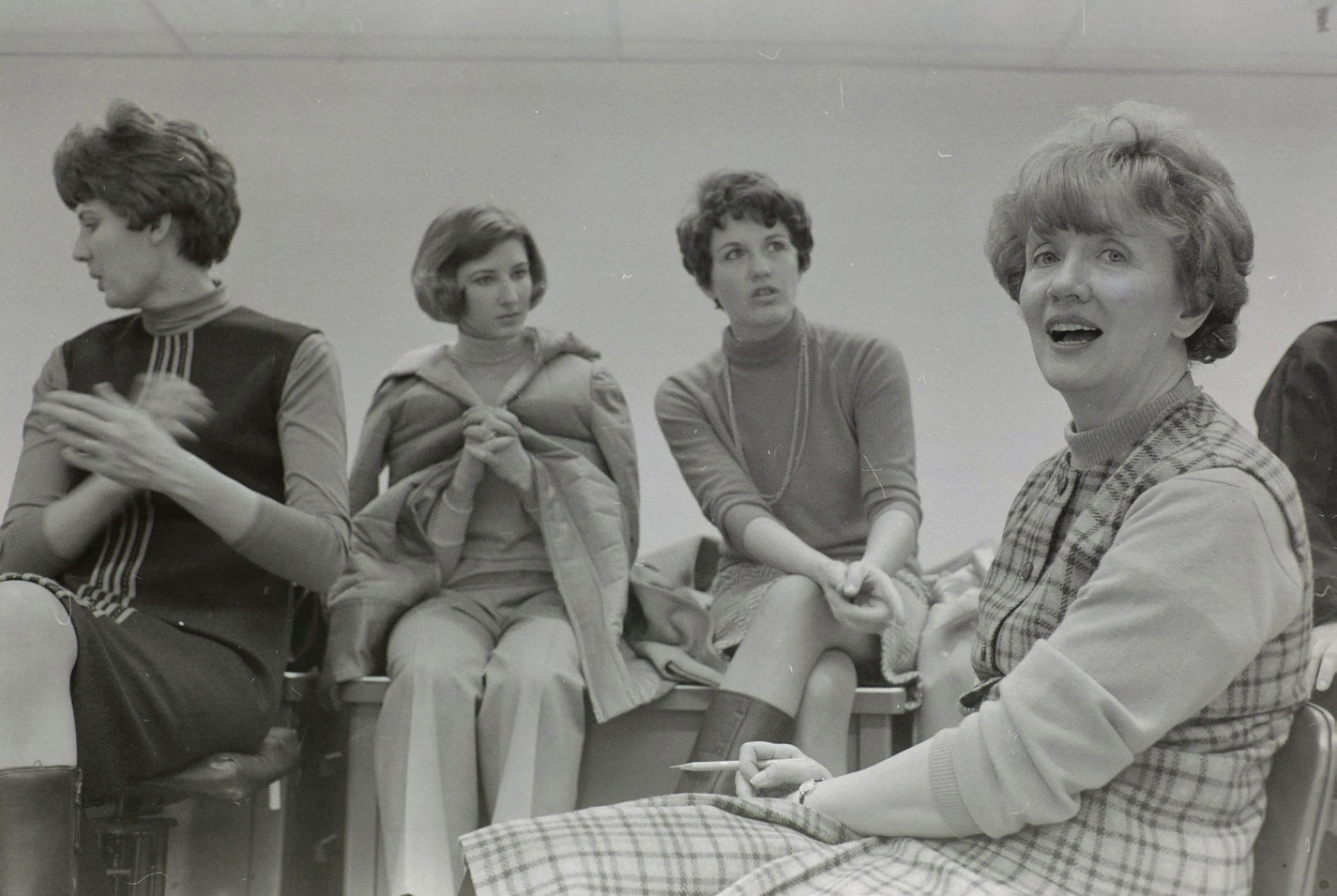
Columnist Barbara Flanagan (right) and other extras await their chance to appear in the movie, Airport. Most of the extras were surprised that sitting was their primary function as an extra. Photo courtesy Minnesota Historical Society.
The most significant change to the airport was the addition of temporary ticket counters opposite the real ones to make the ticketing level look busier and to display more airline names. The old Northwest Orient Airlines ticketing area is prominent across from the temporary Trans Global desk. United Airlines did not want to be featured in an airplane disaster movie, so the filming crew changed their booth to Lufthansa during the evening. There were reports of customers trying to use these fictional stations. Also missing was any hint of airport security. The film was shot long before MSP was reconfigured for metal detectors, when anyone could enter the terminal and walk straight to a gate. In some ways this makes the entire plot of the movie too unbelievable from today’s perspective. The character of the little old-lady stowaway, an Oscar-winning performance by Hayes, certainly could not happen today. (Well, except for 66-year-old Marilyn Hartman who got to London from Chicago by performing the same crime in 2018.¹³)
Film critics panned Airport as an old-school movie with stilted dialogue and a predictable plot. Ross Hunter claimed he only wanted to produce an entertaining film; something that local columnist Don Morrison wrote was “good with popcorn.” Its severest critic was lead actor Lancaster, who called it “the biggest piece of junk ever made.” Yet national audiences made the movie a whopping commercial success, and it spawned a moneymaking genre. Other films shot in Minnesota, like Grumpy Old Men and Fargo, were local sensations, but none made quite the same stir during production as did Airport. Ross Hunter had the hucksterism of a Professor Henry Hill when he announced that he was looking for extras, and Minneapolis-St. Paul was his River City, only too willing to embrace its first Hollywood happening as a respite from everything else that was going on in 1969. Since then, airport security has become numbingly routine, computer-generated imagery and costs have made location shoots less attractive, and local media is more fragmented. It is unlikely to happen again, but when Hollywood came to MSP, Minnesotans loved it.
Bruce Bruemmer is a retired archivist and lives in Minneapolis under runway 12R on approach.
SOURCES
1 “$30,000 Raised at Premiere,” Minneapolis Tribune, March 19, 1970, p. 35.
2 “Film of ‘Airport’ to Use Facilities in Twin Cities,” Minneapolis Tribune, Dec. 17, 1968, pp. 1, 10.
3 Will Jones,“They Also Serve Who Only Stand…,” Minneapolis Tribune, February 23, 1969. Will Jones, “After Last Night,” Minneapolis Tribune, December 19, 1968, p. 28. Barbara Flanagan, Minneapolis Star, December 20, 1968, p. 1B.
4 $15 in 1969 was worth $100 in 2020 if adjusted for inflation in 2020. Carol Nelson, “Movie Madness — It’s Fun to Be Struck — Once!,” St. Paul Dispatch, February 18, 1969, p. 8.
5 “Ross Hunter’s Production ‘Airport’ [advertisement]”, Minneapolis Tribune, p. 10A.
6 Minneapolis-Saint Paul Metropolitan Airports Commission. Wold Chamberlain Field Files. Minnesota Historical Society, St. Paul.
“‘Airport’ Film Costs Soaring,” Minneapolis Star, January 31, 1969, p. 9B.
7 “Movie Crew at Twin City Airport,” The Daily Journal (Fergus Falls), March 1, 1969, p. 7.
8 Barbara Flanagan, Minneapolis Star, February 18, 1969, p. 1C. “Suite Honor,” Minneapolis Tribune, February 22, 1969, p. 12.
9 Will Jones, “Iowa’s Parisienne Flies Into ‘Airport’,” Minneapolis Tribune, February 17, 1969. Jim Klobuchar, Minneapolis Star, February 17, 1969, p. 1B. Barbara Flanagan, “Jogging Not Part of Act,” Minneapolis Star, February 27, 1969, p. 1.
10 “Not for Nancy,” Minneapolis Tribune Magazine, June 29, 1969, p. 6-14.
11 At the time, MSP had runways 4-22 and 11-29, the latter renamed 12-30 after reconfiguration.
12 “Johnson Retires as Manager of Twin Cities Airport,” Minneapolis Tribune, January 25, 1971, p. 4B.
13 “Serial Stowaway Thwarts TSA, Flies Out of’ O’Hare, Chicago Tribune, January 21, 2018, p. A9.
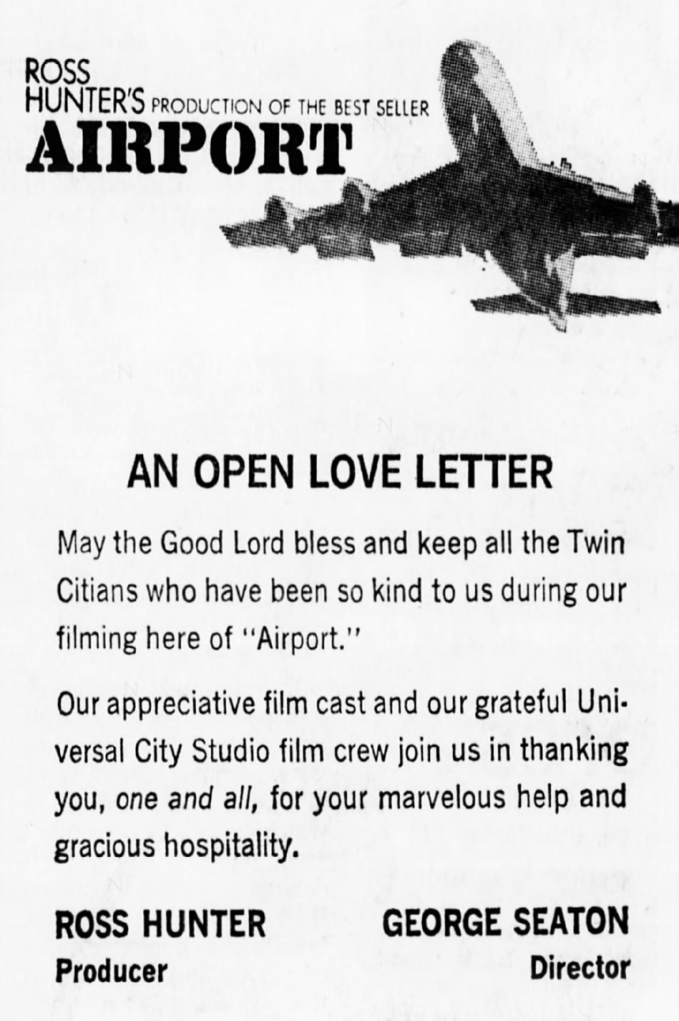
Minneapolis Tribune March 8, 1969.
